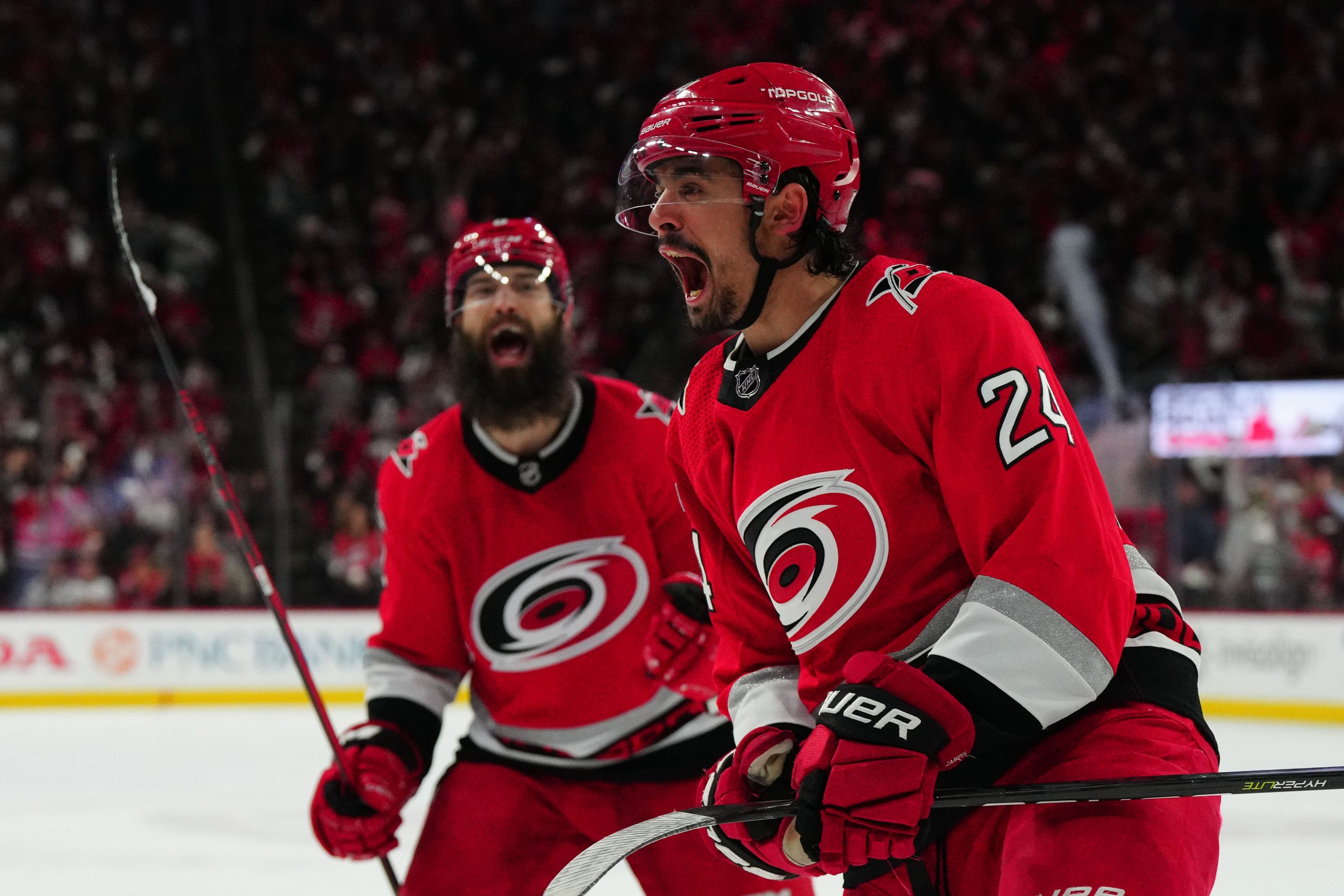While the Carolina Hurricanes season ended in disappointment, the team had a lot to be proud of. Now in the offseason, tough decisions will be made, and management will work to put the team in a place to succeed next season. In the meantime, we will take a look back at individual players’ seasons and see how they did. For the Carolina Hurricanes offseason grades, today we look at Seth Jarvis.
Carolina Hurricanes Offseason Grade: Seth Jarvis
Seth Jarvis is a skilled young forward who plays with a lot of heart. Carolina drafted the former Portland Winterhawk in the first round of the 2020 NHL Entry Draft. The Hurricanes acquired that pick from the Toronto Maple Leafs in the 2020 offseason in exchange for taking on Patrick Marleau‘s salary. Even though Jarvis is a smaller forward, he is not afraid to engage physically and seems to be like the Energizer Bunny on the ice.
While his heart is there, you also cannot ignore Jarvis’s current and potential skills. In his first full professional year in 2021-22, Jarvis played in 68 games and had 17 goals and 23 assists. He saw time on the power play and moved around the lineup, including spending time on the first line. At only 21 years old, Jarvis seems to have a bright future ahead in Carolina.
Seth Jarvis‘s Regular Season
The “sophomore slump” is something that people throw around to describe second year NHL players who statistically regress from their rookie year. Jarvis seemed to suffer only slightly from that slump this season. His goal scoring dropped to 14 while his assists total increased to 25. He finished only one point behind his rookie season even though he played 14 games more this year. Notably, he had no powerplay goals this past season but only one less power-play point than the previous season. On the other side, he had one shorthanded goal.
Jarvis analytically was pretty good this season. His drop in goal scoring seemed to at least somewhat be a product of being a little bit snakebit. He was third on the team in expected goals with 25.2 but only had 14 actual goals. His goals scored above expected was the worst on the team at -11.2. Likewise, his expected goal differential was 38.3 while his actual goal differential was 20.
He spent time on multiple lines but the line of Jarvis, Sebastian Aho and Andrei Svechnikov finished second in the league for forward lines playing at least 100 minutes in expected goal percentage. Most of his time was spent with Aho and Teuvo Teravainen. However, that line finished with 17.7 expected goals and 15 actual goals, good enough for second of all Hurricanes forward lines in both categories. So for the regular season, Jarvis seemed to be generating chances and driving play but had some tough conversion luck.
This was evident in watching him play as well. He had 73 hits and was not afraid to battle in the corners or in front of the net. His skill was really on display at times when he would create turnovers or pick up loose pucks in the neutral zone and then use his speed and strength to get a breakaway or drive the net more reminiscent of a power forward. His ability to also play in all situations made him a pretty key piece for the team, even with his slight drop in production.
Seth Jarvis’s Playoffs
Jarvis’s playoffs were actually a decent uptick from both his previous year’s playoffs and this year’s regular season. In 15 games played, Jarvis scored five goals with five assists. This included two power play goals, one shorthanded goal, and one game-winning goal. For all Hurricanes players, he finished third in points and second in goals and power-play goals during the playoffs. It’s no secret that his production shot up and he was a big factor for Carolina.
But like the regular season, Jarvis’s advanced analytics continued to show how he was driving play. He led the Hurricanes in most categories including expected goals, expected goals per 60 minutes, and expected goals percentage while finishing second in Corsi and Fenwick. One big difference in the playoffs versus the regular season for Jarvis was that his conversion ability (or maybe luck) took a more positive turn. His goals scored above expected went to -1.6 while his expected goal differential of 9.9 was less than his actual goal differential of 13.
Again, Jarvis was a big piece of Carolina’s postseason success. He played most of the time with Aho and Stefan Noesen and that line played more minutes than any other forward line for Carolina. With injuries to Svechnikov and Teravainen, someone had to step up and Jarvis seemed to be one that did that. He continued his hard play with 42 hits and great analytics, but also was able to exhibit more of his skill and chip in on the score sheet. He showed that his chemistry with Aho is something that works well for Carolina on their top line.
The Verdict
Overall, Seth Jarvis had a good year for Carolina. There’s a buzz around Jarvis and expectations, while maybe not through the roof, are pretty high for the young forward. He fits into Carolina’s style and plays at a pace that bodes well for their heavy forechecking style. Even though there were times where he seemed to struggle on the scoresheet during the regular season, he picked it up in the playoffs. At 21 years old, there is no reason to doubt that Jarvis should continue to progress into a top player for Carolina in the near future. In fact, he’s already in that tier.
Jarvis is another Hurricanes player needing a new contract after the 2023-24 season. He will be a restricted free agent at that time so it’s less likely to see him leave. There seems to be a notion that Don Waddell doesn’t like the idea of moving him anyhow at this point unless it was in a big deal. With that said, he was still a big part of Carolina this year and should have more coming soon.
Grade: B+
Check out the last Carolina Hurricanes offseason grades article!
Main Photo: James Guillory-USA TODAY Sports






